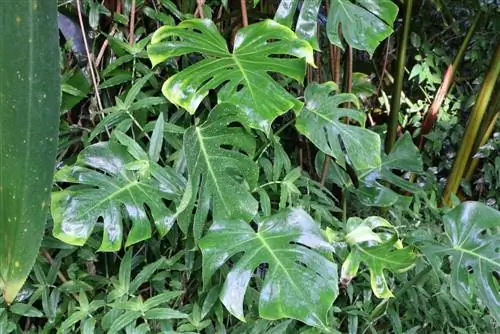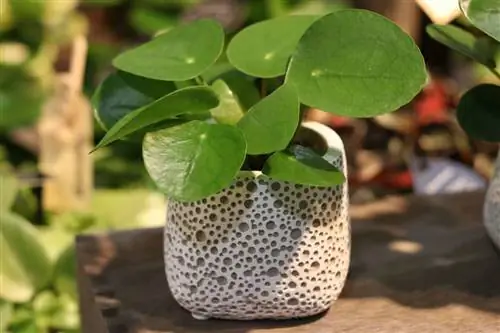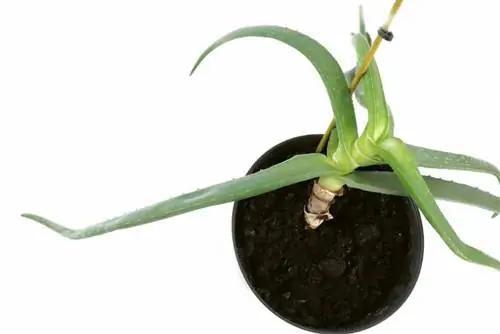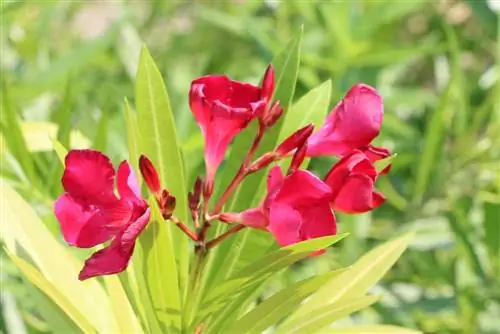- Author admin [email protected].
- Public 2023-12-17 03:39.
- Last modified 2025-01-24 12:45.
The window leaf has the botanical name Monstera deliciosa and has established itself as a popular houseplant in this country. That is why there is often a desire for additional plants that can be propagated quickly and easily through offshoots. The plant forms pronounced aerial roots, which become very long. In addition, the large and partially openwork leaf structures are extremely eye-catching and give the window leaf a distinctive touch.
Head cuttings
Using head cuttings is a simple and quick method to propagate the window leaf through offshoots. Since this is a vegetative reproduction, pure young plants then grow. In order for the head cutting to successfully put down new roots, a suitable offshoot must be selected and the cut must be carried out carefully. If bruising and injuries occur, both the mother plant and the cutting suffer.
- Adequate cutting must already have 2 leaves and 2 aerial roots formed
- Separate offshoots with a sharp and disinfected cutting tool
- Make the cut approx. 0.5-1.0 cm below the aerial root
- Let the interface dry out for at least 1 hour
- Only use fresh cuttings for propagation
- Insert offshoots together with aerial roots in container
- Press the plant substrate carefully
Stem cuttings
If stem cuttings are used as offshoots from the window leaf, then individual pieces of the plant's trunk are used. Several cuttings can be used for propagation at the same time. Certain parts of the shoot axis that are not yet woody are called stem cuttings. The required areas of the Monstera should not yet have any leaves formed, but should contain several leaf buds that are currently dormant. The so-called vegetation points are important for successful propagation with this method. The pieces required for this are cut off at the correct height on the trunk, with the size of the trunk piece determining the subsequent number of trunk cuttings. Growing stem cuttings is relatively uncomplicated if the cutting is done correctly. Within a few weeks, both new roots and leaves develop from the dormant buds.
- Cut off a piece of stem between two dormant buds
- Then divide the larger trunk segment into smaller pieces
- Each section must have some vegetation points
- Place individual trunk pieces straight on the potting soil
- Then press lightly
- Vegetation points must face upwards
growing pot
In order to successfully propagate Monstera offshoots, suitable cultivation pots are required, which are filled with a cultivation substrate. If several cuttings were taken at the same time, each of them should be placed in its own container. To support rooting, it is advisable to erect a transparent hood over the offshoot. In the early days, the right care measures are very important so that the young plants can develop he althily. If the rooting of the offshoots was successful, the small window leaf forms new shoots. At this point, the cover must be completely removed and the plant cared for as normal as an adult specimen.
- A mixture of soil and sand is ideal
- Alternative substrate with coconut fibers possible
- Cover with cling film or clear plastic bag
- Set up wooden sticks as spacers
- Foil must not touch leaves
- Set up in the partially shaded window seat
- Make sure the temperature is warm but not too hot
- Avoid direct sunlight and midday heat
- Keep growing soil slightly moist without interruption
- Water only with lime-free water or rainwater
Tip:
The cover should be removed occasionally for a short period of time so that the cutting is ventilated. Otherwise, the lack of ventilation encourages the growth of harmful mold.
Moosen

Another method for propagating the window leaf through offshoots is mossing, a term from gardening terminology. In this process, the bark is cut at a specific point on the trunk; alternatively, a cut on the main shoot is also possible. The interface must then be permanently prevented from closing. However, it can take some time until enough roots have formed at the interface. Rooting usually takes place after a few weeks or, in extreme cases, even after months. When the time comes, the targeted area below the interface is cut off from the mother plant. Immediately afterwards, the offshoot can be planted as usual.
- Make the cut below the leaf node
- Clamp the interface with a small wooden stick
- Use of matches is also possible
- Cover interface with absorbent material
- Damp soil or peat moss is ideal
- Then carefully wrap with foil
- Seal the film well at the top and bottom
- Keep the material under the film moist throughout the entire period
Care & Timing
The best time to propagate the window leaf through cuttings is at the beginning of the growing season. During this phase, the Monstera begins to grow again after winter dormancy, so that leaves and roots can quickly form on the offshoot. Propagation through head and stem cuttings can be carried out at the same time as pruning the plant. The evergreen plant originally comes from the tropical forests of the Caribbean and South America. There it grows beneath the large trees and is therefore used to semi-shady conditions. For this reason, the window leaf cannot cope with blazing sunlight and strong midday heat. The plant also depends on high humidity. As a climbing plant, Monstera grows quickly and therefore needs sufficient space at the top. Due to its growth habit, the window leaf forms very flexible aerial roots. Despite their flexible properties, the aerial roots can easily break off.
- It is ideal to propagate through cuttings in spring
- Growing possible in planters
- Aerial roots must be covered with soil
- Offshoots can alternatively be rooted in a glass of water
- Aerial roots must then be in the water
- Plant directly afterwards
- Plant is happy about additional support in the pot
- Leaves need a lot of moisture
- The use of rainwater is optimal
- Treat aerial roots carefully to prevent them from breaking off
Tip:
Sprinkle offshoots and newly grown young plants from a short distance with lime-free water from a spray bottle. Additionally, wet the leaves individually with a slightly damp sponge.






